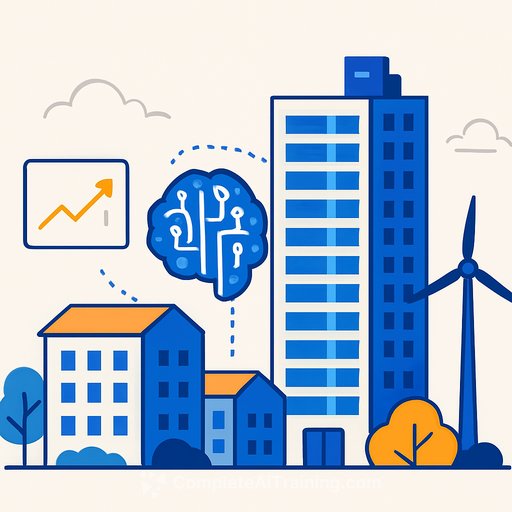AI Is Driving a New Data Center Build-Out: What Owners, Developers, and GCs Need to Know
AI workloads have spiked demand for data centers across the U.S. over the past five years. There are now 3,000+ confirmed facilities nationwide, and a McKinsey analysis projects $5.2 trillion in AI infrastructure investment by 2030, with roughly 15% flowing to land, materials, and site development.
That surge is showing up in architecture fees. Corgan and HDR, long active in the sector, have seen major gains: Corgan grew from ~$61M (2020) to ~$135M (2024); HDR from ~$34M to ~$130M. The takeaway for real estate and construction teams: this is a durable pipeline, but it is constrained by power, land, and community tolerance.
Who's Driving Demand
Growth is led by hyperscalers-Google, Meta, Microsoft, and Amazon-serving clients that need massive compute. These facilities typically start around 10,000 square feet and host 5,000+ servers.
"AI is still in the inference gathering stage," said Tom Widawsky, technical principal at HDR. These companies are racing to get from training to application, and that means building fast-and building big.
Where They're Going (and Why It's Not Simple)
Traditional hubs like Northern Virginia have fiber, substations, and skilled labor. But land constraints and grid bottlenecks are pushing builds into new markets that often lack heavy-duty electrical infrastructure. That shift affects everything from building massing to schedule.
"The demand they're having to serve is changing so quickly that we do have to reevaluate almost the entire building as part of each delivery," said Dan Drennan, managing principal and data center leader at Corgan. More multistory configurations are showing up as teams squeeze capacity onto tighter sites.
Making Boxes People Accept
Communities are asking for better architecture and a lighter touch. "A higher level of design is being required on the exterior so they blend in as much as possible," noted Joy Hughes, global accounts director at Gensler. Early dialogue with jurisdictions is now a must-have, not a nice-to-have.
- Use articulated envelopes, color breaks, and screened yards to reduce visual mass.
- Mitigate noise with enclosures, orientation, and setbacks.
- Buffer with landscape and treat streets like office or light industrial, not heavy warehouse.
Power, Cooling, and Water: The Operational Reality
A single ChatGPT prompt can use roughly 10x the energy of a standard web search. Data centers already account for about 4.4% of U.S. electricity, with some forecasts suggesting it could approach ~12% by 2028.
Because utility upgrades lag demand, some sites start with temporary fossil-fuel generators and keep them for redundancy. The grid impact is real and can push local energy prices up as providers pass costs through to ratepayers.
Cooling is the other constraint. As server densities climb, air systems alone struggle. Closed-loop liquid cooling is gaining share, easing water use compared with open systems and unlocking higher rack densities.
What Design and Construction Teams Can Actually Control
- Embodied carbon cuts: Hybrid mass timber and steel structures (as piloted by Gensler and Thornton Tomasetti in Northern Virginia) and low-carbon concrete mixes.
- Envelope and heat management: High-performance walls/roofs, solar control, and smart zoning to reduce mechanical loads.
- Mechanical efficiency: High delta-T designs, liquid-to-liquid heat exchangers, and optimized free-cooling where climate allows.
- Local sourcing: Shorter lead times, lower transport emissions, and better cost control.
- Utility coordination: Lock substation capacity early, stage switchgear, and align energization dates with commissioning.
The Sustainability Ceiling
Most emissions in this asset class come from operations, not construction-the opposite of typical commercial buildings. Timber, concrete improvements, and efficient MEP help, but they can't neutralize rising electricity use.
Some of the largest campuses will soon consume as much energy as small cities. Morgan Stanley estimates sector emissions could hit 2.5 billion metric tonnes CO₂ by 2030. Small modular reactors are being explored, but until the grid is cleaner, emissions will track demand.
Action Checklist for Owners, Developers, and GCs
Site and Power
- Prioritize parcels within short runs to high-capacity substations and diverse fiber paths.
- Secure interim power strategies (temporary generation, phased energization) to protect schedules.
- Confirm water rights or design for closed-loop liquid cooling to reduce draw.
Entitlements and Community
- Start outreach early; show massing options, noise data, and visual simulations.
- Commit to high-quality exteriors and landscape buffers in writing.
- Be transparent about grid impacts and timelines to avoid backlash late in permitting.
Building and Systems
- Design for higher densities and liquid-ready bays even if phase one is air-cooled.
- Use modular MEP skids to compress schedules and simplify maintenance.
- Target low-carbon concrete and consider hybrid timber/steel where code and loads allow.
Schedule and Risk
- Preorder long-lead equipment (transformers, switchgear, chillers) against flexible design packages.
- Structure contracts to handle phased energization and partial handovers.
- Model OPEX early; power procurement and cooling choices will drive total cost far more than finish level.
Commercial Reality
- Fees and margins are healthy, but the bottleneck is utilities and land-not floor plans.
- Winning teams pair site control with utility readiness and fast, repeatable delivery.
Bottom line: Demand is here, but the projects that pencil are the ones that lock power, move fast, and stay flexible-on structure, cooling, and phasing.
If your team needs practical AI fluency to speak with hyperscalers and enterprise clients, explore focused programs at Complete AI Training.
Your membership also unlocks:






